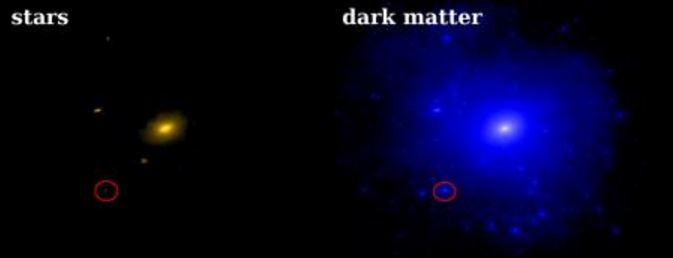A huge dark matter concentration has been discovered in a nearby dwarf galaxy called Triangulum II. Dark matter is estimated to outnumber regular (visible) matter particles in the Universe by more than a factor of 10. But the proportion appears to be much higher in Triangulum II.
Dark matter was first identified by Fritz Zwicky (1898-1974), a Swiss astronomer in 1933. We know dark matter exists although we cannot see it or physically detect it. It has a gravitational pull that attracts visible matter and distorts light.
Assistant Professor of Astronomy Evan Kirby, who works at the California Institute Of Technology (Caltech), and colleagues from the Observatories of the Carnegie Institution of Washington and the University of California wrote about their study in Astrophysical Journal Letters.
 This Caltech FIRE simulation shows the predicted distribution of stars (left) and dark matter (right) around a galaxy like the Milky Way. The red circle shows a dwarf galaxy like Triangulum II. It has lots of dark matter but few stars. (Image: Caltech. Credit: A. Wetzel and P. Hopkins)
This Caltech FIRE simulation shows the predicted distribution of stars (left) and dark matter (right) around a galaxy like the Milky Way. The red circle shows a dwarf galaxy like Triangulum II. It has lots of dark matter but few stars. (Image: Caltech. Credit: A. Wetzel and P. Hopkins)
Highest dark matter concentration of any galaxy
By measuring the mass of dwarf galaxy Triangulum II, the scientists found it has the highest concentration of dark matter of any galaxy we know of. A dwarf galaxy is a small galaxy.
Triangulum II, a faint galaxy at the edge of our galaxy (Milky Way), comprises only about 1,000 stars. This is a tiny number compared, for example, to the Milky Way, which is estimated to have over 100 billion stars.
Prof. Kirby measured Triangulum II’s mass by examining the velocity of six stars whizzing around its center.
Prof. Kirby said:
“The galaxy is challenging to look at. Only six of its stars were luminous enough to see with the Keck telescope.”
By measuring the velocity of these stars, Prof. Kirby was able to infer the gravitational force exerted on them and thereby determine the galaxy’s mass.
Prof. Kirby said:
“The total mass I measured was much, much greater than the mass of the total number of stars – implying that there’s a ton of densely packed dark matter contributing to the total mass.”
“The ratio of dark matter to luminous matter is the highest of any galaxy we know. After I had made my measurements, I was just thinking – wow!”
Triangulum II a good candidate for dark matter research
Triangulum II will likely become a leading candidate in attempts by scientists to directly detect the signatures of dark matter.
Certain dark matter particles, called supersymmetric WIMPs (weakly interacting massive particles), destroy one another when they collide, and produce gamma rays that we can then detect from Earth.
Current theories suggest that dark matter is producing gamma rays across virtually the whole of the Universe. However, detecting these specific signals among other galactic ‘noises’, such as gamma rays emitted from pulsars (rapidly rotating neutron stars), is extremely difficult.
Triangulum II is a ‘quiet’ galaxy
Triangulum II does not have much galactic noise – it is a relatively quiet galaxy. It does not have the required gas and other material to form stars, so it is not forming new stars – scientists call it ‘dead’.
In theory, any gamma ray signals coming from dark matter particles that collided in Triangulum II would be clearly visible.
Prof. Kirby’s measurement of the total mass of Triangulum II has not been definitely confirmed. Another team, led by scientists from the University of Strasbourg in France, measured the speeds of stars just outside this dwarf galaxy and found they were actually moving faster than the one’s close to its center – which is exactly the opposite of what everyone had expected.
This surprising finding suggests that Triangulum II is being pulled apart, or ‘tidally disrupted’ by gravity from our Milky Way.
Prof. Kirby said:
“My next steps are to make measurements to confirm that other group’s findings. If it turns out that those outer stars aren’t actually moving faster than the inner ones, then the galaxy could be in what’s called dynamic equilibrium. That would make it the most excellent candidate for detecting dark matter with gamma rays.”
Citation: “TRIANGULUM II: POSSIBLY A VERY DENSE ULTRA-FAINT DWARF GALAXY,” Evan N. Kirby, Judith G. Cohen, Joshua D. Simon, and Puragra Guhathakurta. Astrophysical Journal Letters. 16 November, 2015. DOI: http://dx.doi.org/10.1088/2041-8205/814/1/L7.

